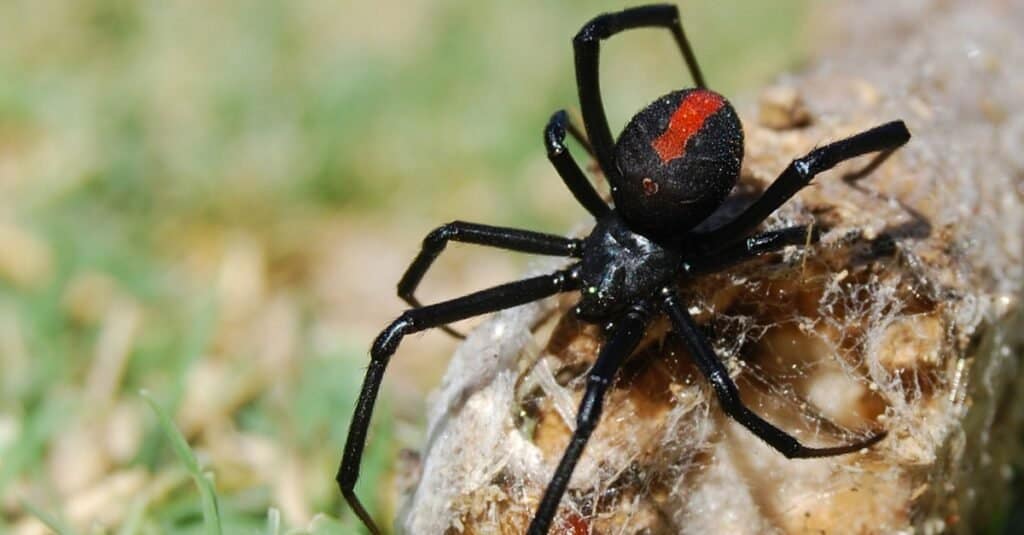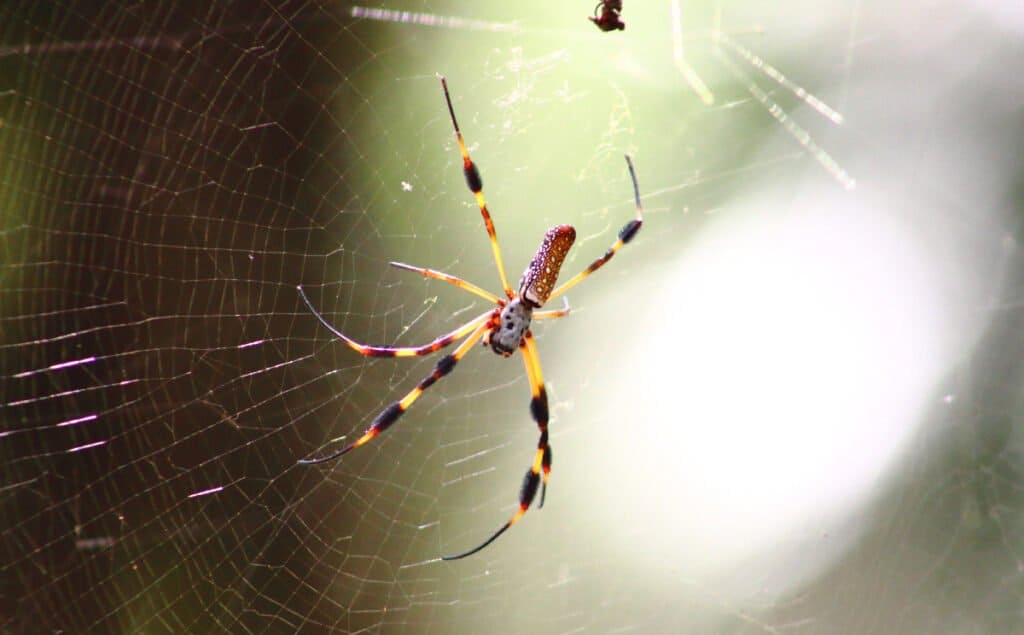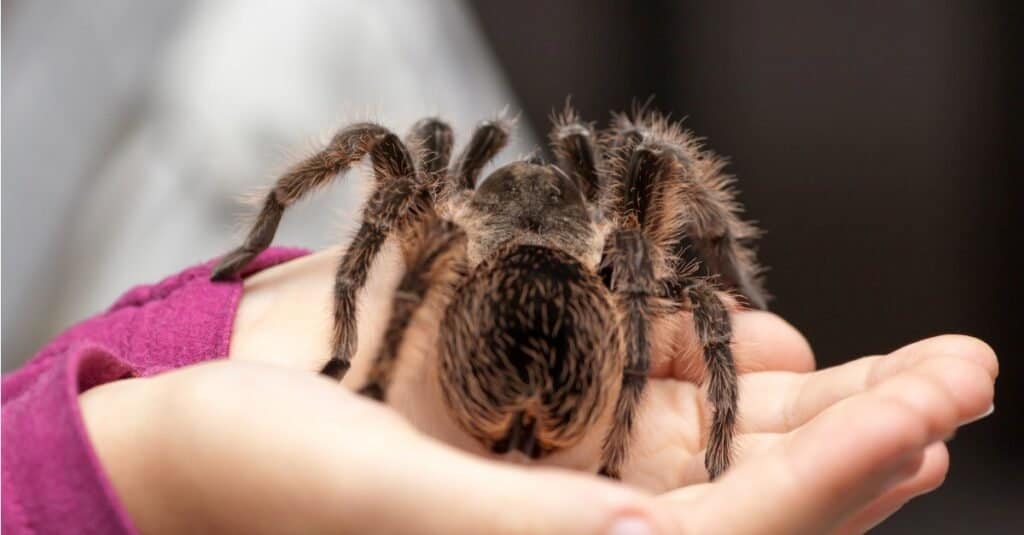Are spiders capable of killing snakes? Think about a spider the size of a quarter and a snake the size of a jump rope? How could a spider kill a snake 30 times its size? A recent research study looked at 319 incidents of snakes being killed by spiders worldwide. The results were astonishing! Incidents were reported on all continents (except Antarctica). More than 40 different spider species were reported to kill snakes. There were more than 90 different snake species that were killed by spiders. So, this seems more common than researchers believed. It is one thing to have a small snake show up on your web, but another thing for spiders to hunt and kill snakes. Are there any spiders that hunt and kill snakes 30 times their size? Let’s find out!
3 Kinds of Spiders that Kill Snakes
1) Widow Family (Tangle Web Spiders, theridiids)

The Australian redback is one of the spiders that can kill a snake.
©iStock.com/maria72
- Australian redback
- African button
- Israeli widow spider
- North American widow spiders (4 species) like the black widow
- Latrodectus geometricus
- L. Hesperus
- Latrodectus mactans
- Latrodectus variolus Walckenaer
2) Orb Weavers

Golden silk orb-weavers can spin a web that is nearly five feet across.
©Max Rossa/Shutterstock.com
- Nephila (like the golden silk orb-weaver)
- Trichonephila (like the Joro spider)
3) Tarantulas

Tarantulas will ambush snakes and bite them with their fangs, injecting toxic venom.
©iStock.com/waldru
- Brachypelma (like the Mexican fireleg tarantula)
- Dolomedes tenebrosus (like fishing spiders)
- Grammostola quirogai (Uruguay black beauty)
- Theraphosa blondi (Goliath bird-eater tarantula)
How do web-weaving spiders kill snakes?
The widow spiders (like the black widow) and the orb-weavers both spin webs and wait for their prey to come to them. Widow spiders spin flat webs that are close to the ground, so it may be more likely to have ground-crawling snakes accidentally get tangled in their web. Orb-weaving spiders spin elaborate orb-shaped webs, some with golden-colored silk.
If a snake were to get tangled in a web accidentally, the spider would immediately spin more web around it to keep it from wriggling away and pierce its skin with its fangs and inject it with venom. The venom takes action by immobilizing the nervous system, and the enzymes start to digest the snake’s body. Since the snake is paralyzed, it can’t break free from the web. The spiders then wait for the body to liquefy and suck up the nutrients. It may take days to digest a larger snake.
How do hunting spiders kill snakes?
Hunting spiders like the tarantula don’t just wait around. They sneak out at night and actively seek prey. They can sense vibrations in the ground to figure out where prey is nearby. When they find a frog, lizard, or snake, they ambush it by leaping sideways and surprising it. They will inject the prey with venom and wait for it to be subdued. The chemicals in the venom also digest the flesh so that the spiders can use their straw-like mouth to suck up the remaining liquid body.
How do tarantulas kill snakes?
Tarantulas kill snakes by jumping on their heads and piercing their skin with sharp fangs, releasing their venom. They will sometimes hold on for dear life as the snake thrashes around, like a snake rodeo! By hanging on to their heads, they can avoid being bitten by the snake in retaliation. This is extremely important when attacking a poisonous snake!
Do spiders attack poisonous snakes?

Juvenile rattlesnakes can be prey to spiders.
©iStock.com/Tee-roy
Yes! Many of the snake species mentioned in the research were very venomous snakes like New World coral snakes, Australian brown snakes, rattlesnakes, and lanceheads. One of the venomous snakes in the research was an Eastern brown snake, a snake from Australia! It is unclear if some spiders are immune to snake venom or if they just avoid getting bitten. There are cases where venomous snakes feed on spiders, so the winner may depend on who bites first.
Can a spider kill a snake 30 times its size?
Yes! The research on spider-eating snakes showed that the largest snake in the study was a 75 cm (29.5-inch) adult green snake. That snake was found tangled in the web of a golden silk orb-weaver (average size of 2.54 cm or 1 inch). Doing the math, a one-inch spider killed and ate a 30-inch green snake! Yikes!
What about the hunting spiders?

The Goliath bird-eating tarantula will attack and kill small birds and can attack and kill snakes.
©iStock.com/Dan Olsen
Goliath bird-eating tarantulae have been witnessed consuming large snakes in captivity during research. A group of researchers came across the first tarantula eating a snake in the wild in Brazil. In Serra do Caverá, in the south of Brazil, a group was studying tarantulas in December of 2016 when they shuffled a rock to reveal a long Almaden ground snake (Erythrolamprus almadensis). Not that uncommon to find snakes under rocks in this area, but it was uncommon to find a large tarantula eating the snake! The tarantula was identified as a Grammostola quirogai (Uruguay black beauty). These spiders are not as big as Goliath bird-eating tarantulas, but they still have fangs nearly an inch long (2 cm)!
Uruguay black beauty tarantulas are hand-sized spiders that average 6 inches (15.24 cm), and the Almaden ground snake was 15 inches (39 cm). If only the researchers could have arrived in time to watch the attack and see if the tarantula had an 8-second ride on the bucking snake before it succumbed! “Wild Snake Rodeo Caught on Tape” would be a great headline!
The photo featured at the top of this post is © ROSA ROMERO HERRERA/Shutterstock.com
Thank you for reading! Have some feedback for us? Contact the AZ Animals editorial team.






